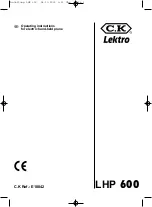
3
CFD-S03CP/S03CPL
TABLE OF CONTENTS
1.
SERVICING NOTES
................................................
4
2.
GENERAL
...................................................................
5
3.
DISASSEMBLY
3-1.
Cabinet (Rear) Assy .........................................................
7
3-2.
Cabinet (Front) Assy, Cabinet (Upper) Assy ...................
7
3-3.
Main Board ......................................................................
8
3-4.
CD Block Assy ................................................................
8
3-5.
BD83S Board ..................................................................
9
3-6.
Optical Pick-up ................................................................
9
3-7.
Panel Board ..................................................................... 10
3-8.
CD Lid ............................................................................. 10
3-9.
Tape Mechanism Block, Belt (1), Belt (2) ...................... 11
3-10. TC Board ......................................................................... 11
3-11. Key-1 Board, Key-2 Board .............................................. 12
3-12. Power Board .................................................................... 12
4.
MECHANICAL ADJUSTMENTS
......................... 13
5.
ELECTRICAL ADJUSTMENTS
Tape Section .................................................................... 13
Tuner Section ................................................................... 14
CD Section ...................................................................... 16
6.
DIAGRAMS
6-1.
Block Diagram – CD Section – ....................................... 17
6-2.
Block Diagram – Main Section – .................................... 18
6-3.
Circuit Boards Location .................................................. 19
6-4.
Printed Wiring Board – BD83S Section – ....................... 20
6-5.
Schematic Diagram – BD83S Section – .......................... 21
6-6.
Printed Wiring Board – Main Section – .......................... 22
6-7.
Schematic Diagram – Main Section (1/3) – .................... 23
6-8.
Schematic Diagram – Main Section (2/3) – .................... 24
6-9.
Schematic Diagram – Main Section (3/3) – .................... 25
6-10. Printed Wiring Boards – TC Section – ............................ 26
6-11. Schematic Diagram – TC Section – ................................ 27
6-12. Printed Wiring Boards – Panel Section – ........................ 28
6-13. Schematic Diagram – Panel Section – ............................ 29
6-14. Printed Wiring Boards – Power Supply Section – ........... 30
6-15. Schematic Diagram – Power Supply Section – ............... 31
7.
EXPLODED VIEWS
7-1.
Rear Cabinet Section ....................................................... 39
7-2.
Front Cabinet Section (1) ................................................ 40
7-3.
Front Cabinet Section (2) ................................................ 41
7-4.
Upper Cabinet Section (1) ............................................... 42
7-5.
Upper Cabinet Section (2) ............................................... 43
7-6.
CD Mechanism Section ................................................... 44
8.
ELECTRICAL PARTS LIST
.................................. 45
•
UNLEADED SOLDER
Boards requiring use of unleaded solder are printed with the lead-
free mark (LF) indicating the solder contains no lead.
(Caution: Some printed circuit boards may not come printed with
the lead free mark due to their particular size.)
: LEAD FREE MARK
Unleaded solder has the following characteristics.
• Unleaded solder melts at a temperature about 40
°
C higher than
ordinary solder.
Ordinary soldering irons can be used but the iron tip has to be
applied to the solder joint for a slightly longer time.
Soldering irons using a temperature regulator should be set to
about 350
°
C.
Caution: The printed pattern (copper foil) may peel away if the
heated tip is applied for too long, so be careful!
• Strong viscosity
Unleaded solder is more viscous (sticky, less prone to flow)
than ordinary solder so use caution not to let solder bridges
occur such as on IC pins, etc.
• Usable with ordinary solder
It is best to use only unleaded solder but unleaded solder may
also be added to ordinary solder.




































